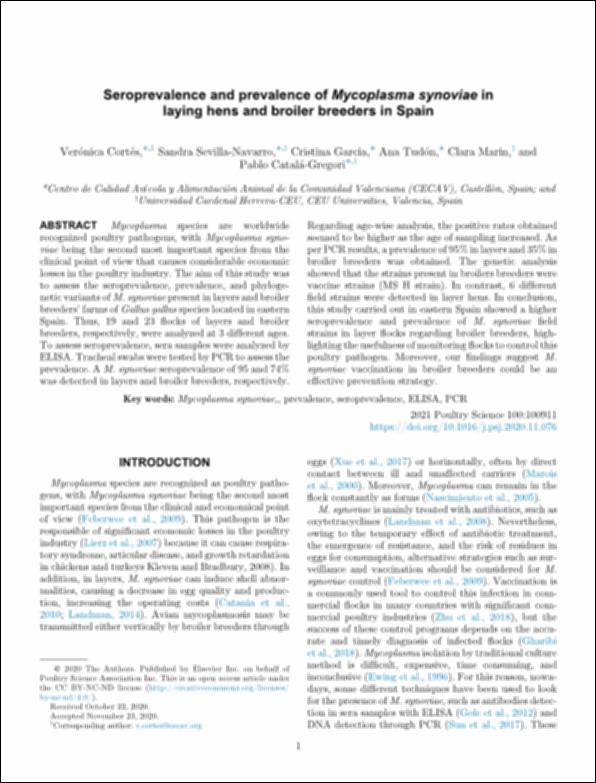Por favor, use este identificador para citar o enlazar este ítem:
http://hdl.handle.net/10637/13466Seroprevalence and prevalence of "Mycoplasma synoviae" in laying hens and broiler breeders in Spain
| Título : | Seroprevalence and prevalence of "Mycoplasma synoviae" in laying hens and broiler breeders in Spain |
| Autor : | Cortés Moñiz, Verónica Sevilla Navarro, Sandra García Bover, Cristina Tudón Gómez, Ana Lorena Marín Orenga, Clara Catalá Gregori, Pablo |
| Materias: | Veterinaria preventiva.; Veterinary preventive.; Aves de corral - Enfermedades infecciosas.; Poultry - Communicable diseases.; Mycoplasma synoviae.; Gallinas - Cría y explotación.; Aves de corral - Vacunación.; Poultry - Vaccination.; Hens - Breeding. |
| Editorial : | Elsevier |
| Citación : | Cortés, V., Sevilla-Navarro, S., García, C., Tudón, A., Marín, C. & Catalá-Gregori, P. (2021). Seroprevalence and prevalence of "Mycoplasma synoviae" in laying hens and broiler breeders in Spain. Poultry Science, vol. 100, i. 3 (mar.), art. 100911. DOI: https://doi.org/10.1016/j.psj.2020.11.076 |
| Resumen : | Mycoplasma species are worldwide recognized poultry pathogens, with Mycoplasma synoviae being the second most important species from the clinical point of view that causes considerable economic losses in the poultry industry. The aim of this study was to assess the seroprevalence, prevalence, and phylogenetic variants of M. synoviae present in layers and broiler breeders’ farms of Gallus gallus species located in eastern Spain. Thus, 19 and 23 flocks of layers and broiler breeders, respectively, were analyzed at 3 different ages. To assess seroprevalence, sera samples were analyzed by ELISA. Tracheal swabs were tested by PCR to assess the prevalence. A M. synoviae seroprevalence of 95 and 74% was detected in layers and broiler breeders, respectively. Regarding age-wise analysis, the positive rates obtained seemed to be higher as the age of sampling increased. As per PCR results, a prevalence of 95% in layers and 35% in broiler breeders was obtained. The genetic analysis showed that the strains present in broilers breeders were vaccine strains (MS H strain). In contrast, 6 different field strains were detected in layer hens. In conclusion, this study carried out in eastern Spain showed a higher seroprevalence and prevalence of M. synoviae field strains in layer flocks regarding broiler breeders, highlighting the usefulness of monitoring flocks to control this poultry pathogen. Moreover, our findings suggest M. synoviae vaccination in broiler breeders could be an effective prevention strategy. |
| Descripción : | Este artículo se encuentra disponible en la siguiente URL: https://www.sciencedirect.com/science/article/pii/S0032579120309627?via%3Dihub |
| URI : | http://hdl.handle.net/10637/13466 |
| Derechos: | http://creativecommons.org/licenses/by-nc-nd/4.0/deed.es |
| ISSN : | 0032-5791 1525-3171 (Electrónico) |
| Fecha de publicación : | 8-mar-2021 |
| Centro : | Universidad Cardenal Herrera-CEU |
| Aparece en las colecciones: | Dpto. Producción y Sanidad Animal, Salud Pública Veterinaria y Ciencia y Tecnología de los Alimentos |
Los ítems de DSpace están protegidos por copyright, con todos los derechos reservados, a menos que se indique lo contrario.


